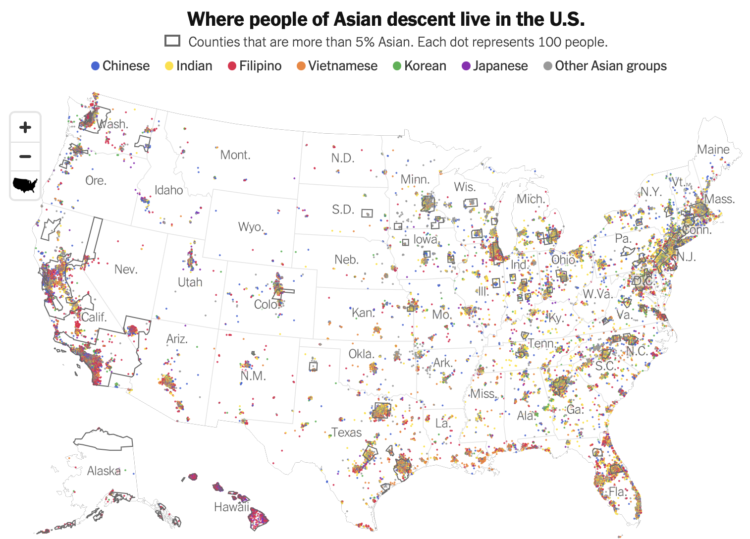Adrian Blanco for The Washington Post used squares connected at the corners to compare federal judge confirmations across presidencies. Each square represents a demographic, which is sized by number of confirmations. I like it.
Tag Archives: diversity
Posted by in diversity, Joe Biden, judges, Statistical Visualization
Diversity within the Asian population
Robert Gebeloff, Denise Lu and Miriam Jordan for The New York Times looked at overall increases and variation within the Asian population:
North Dakota, South Dakota, Texas, North Carolina and Indiana are among states that experienced major growth in the past decade. And people of Asian descent have been settling in ever larger numbers in states like West Virginia, where the overall population has declined.
Tags: Asian, diversity, New York Times
Posted by in Asian, diversity, maps, New York Times
Analysis of skin tones in beauty ads on Instagram
For Quartz, Amanda Shendruk and Marc Bain analyzed skin tones that appeared in beauty and fashion ads on Instagram. The graphics use Blackout Tuesday on June 2, 2020, when many brands vowed to improve diversity to better reflect the world, as a point of comparison. Using median skin color as the main metric, some companies shifted more than others.
School diversity visualized with moving bubbles
The Washington Post visualized 13,000 school districts to show the change in diversity between 1995 and 2017. Each bubble represents a district and the size represents number of students. The bubbles transition to diverse, undiverse, and extremely undiverse. It’s an important topic and worth the read.
But right now, all I can think about is that I need to up my moving bubble game.
Tags: diversity, school, Washington Post
Posted by in diversity, Infographics, school, Washington Post
Faces of diverse midterms
As one might expect, many women, people of color, and L.G.B.T. candidates are running in this year’s midterms. It’ll be one of the most diverse elections in U.S. history. The New York Times provides a scrolly breakdown with 410 cutout faces floating around on your screen.
Posted by in diversity, election, Infographics
Mapping a diverse but segregated America
Aaron Williams and Armand Emamdjomeh for The Washington Post delve into diversity and segregation in the United States. The boiling pot continues to get more ingredients, but they’re not mixing evenly.
Some 50 years ago, policies like the Fair Housing Act and Voting Rights Act were enacted to increase integration, promote equity, combat discrimination and dismantle the lingering legacy of Jim Crow laws. But a Post analysis shows that some cities remain deeply segregated — even as the country itself becomes more diverse.
I like how you can easily toggle between diversity and segregation. It allows for a quick comparison of metrics that aren’t always clear-cut.
Scroll to the end to see how diversity and segregation compare in your area.
Tags: diversity, race, Washington Post
Posted by in diversity, maps, race, Washington Post
Statistical diversity in US newsrooms
If a news organization wants to talk about the world in a fair way, it needs points of view from a group of people who are representative of said world. Otherwise, bias comes to play no matter how hard you try. Google Trends looks at the how different groups are represented in major news organizations across the country.
Posted by in diversity, Google, news, Statistical Visualization
Increasing diversity
Dan Keating and Laris Karklis for The Washington Post map the change in diversity since 2000. The color scale, shown in the top right, represents two things: level of diversity and change in diversity. I’m not so sure the dual scale is interesting as a whole, as my brain just wants to split out each category individually or see each one separately. But keep scrolling and you can get that separation, which is a lot more visually helpful.
See also: percentage of white people, majority minorities, and predominant race.
Tags: diversity, Washington Post
Posted by in diversity, maps, Washington Post
Diversity percentages for US schools
Based on 2014 estimates from the U.S. Department of Education, the Chronicle of Higher Education compiled a straightforward searchable and sortable table that shows the race percentages for more than 4,600 institutions.
FYI: The search function is basic, and you have to enter a school’s name to match as it is entered in the system. For example, a search for “Berkeley” only shows the schools that start with that but not University of California at Berkeley. And a search for “University of California” pulls up zero results, because it’s listed as “U. of California.”
Posted by in Data Sources, diversity, education








